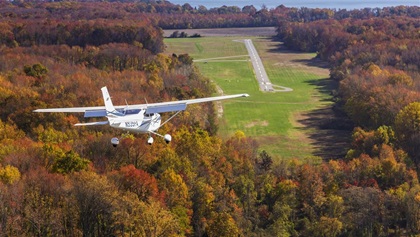Real-world cross-country planning
A successful cross-country flight is more than just A to B

But in the real world, there are other important issues to consider. Like, for instance, where’s the best free popcorn? Is there a courtesy car? Plus, how much did you say it costs to tie down for the night?
Real-world range
Just as in flight training, range is a key consideration when traveling by personal aircraft, but it’s not the range of the aircraft. It’s the range of the pilot.
The unprepared pilot—the one who plans for the airplane’s range without regard to human factors—typically encounters FBS (full bladder syndrome) when the nearest airport is 30 minutes away. And I’m talking flight time. You still have to enter the pattern, land, taxi to the apron, shut down, and then find the biological relief facilities. Adding turbulence makes FBS that much worse.
Hence, the number one consideration in real-world cross-country planning is not the range of the aircraft, but the range of the pilot (or the shortest-range passenger).
While bladder capacity is a biggie, it’s not the only consideration. How long can you sit before your back aches, your legs cramp, or your butt hurts? It’s better to fly shorter legs in physical comfort than suffer longer flights needlessly. Besides, the extra landings will make you a better pilot, and you’ll get to see some interesting places and meet interesting people you otherwise would have missed. And isn’t that what aviation is all about?
The three Fs: Field, fuel, and FBO
In a real-world cross-country, the location of the airports where you land—whether to take care of biology, stretch your legs, refuel, or spend the night—is less important than you might think. On a flight of any distance, modest diversions make precious little difference in the total flight time. A host of other factors also play a role in deciding where to stop.
The field: First, consider the field itself—specifically, the runways. Ensure the length of any runway you intend to land on is within the capabilities of you and your aircraft. And note the number of runways. According to the FAA, 3,200 of the of the country’s 4,933 public airports—nearly 65 percent—have only a single strip of pavement. If crosswinds worry you, choosing a field with two or more strips will help your traffic pattern mental state.
The fuel: Another important consideration is fuel, if you require it on any given stop. When it comes to fuel there are really only two questions: Can you get it when you want it, and what does it cost?
Let’s start with availability. If the airport has fuel, is it sold from a truck or is there a self-serve pump? Which do you prefer? Oh, and know that just because there’s a self-serve pump on the field, it doesn’t necessarily mean you can buy fuel 24/7 year-round. Some places turn off the pumps at night or on weekends. In some areas of the country, fuel sales on Sundays can be hard to find. Check the chart supplement or your favorite flight planning tool. It also never hurts to dash off a quick email, or call to double check the facts as part of your flight planning process.
Second only to fuel availability in real-world cross-country planning is the cost of that fuel, which varies more than you’d expect. Different regions of the country tend to have cheaper or more expensive fuel, but sometimes prices vary tremendously within a few minutes flight time. Looking at Amarillo, Texas, on iFlightPlanner for AOPA, for instance, I see three places I can land and tank up on 100LL. At Rick Husband Amarillo International Airport, a friendly Class C, the fuel is $7.80 per gallon. At Tradewind Airport, just outside the Class C core and under its shelf, that drops to $6.18. Meanwhile, southwest of the airspace at Hereford Municipal Airport the gas is $5.49 a gallon—that’s $2.31 cents per gallon less than at the “big” airport. If you’re filling up a typical general aviation airplane, flying that extra distance will pay for your hotel room for the night.
The FBO: Service providers at airports are generally called FBOs, or fixed-base operators. FBOs provide a wide range of services to pilots including fuel sales and the all-important bathrooms.
Most Class C airports and many busy Class D have multiple fully staffed FBOs. At a remote Class G airport, the “FBO” might be a small unstaffed shack with a locked door coded to the CTAF frequency. So beyond which has a clean bathroom (not all do), how do you choose?
One way is by reputation, or in the case of a chain FBO, the reputation of the chain. Another way is by considering what they offer, starting with snackage. Many FBOs of fer water, coffee, sodas, popcorn, and even fresh-baked cookies. At well-staffed FBOs, these are often free to you and your passengers. At unstaffed FBOs there might be a donation box or a price list.
fer water, coffee, sodas, popcorn, and even fresh-baked cookies. At well-staffed FBOs, these are often free to you and your passengers. At unstaffed FBOs there might be a donation box or a price list.
FBOs generally control aircraft parking at airports as well, which comes in two flavors: tiedown and hangar. If you hangar at your home base, and tie down when traveling, you’ll probably hear your airplane whimper as you walk away from it. (You wouldn’t chain up a dog out in the open in a strange place, would you?) The good news is that many airports have “transient” hangar space available for airplanes passing through. Check the cost in advance, however, as prices differ greatly. I’ve paid as little as nothing (a great deal) to more for a single night than I pay for a month of hangar rent back home. That said, a common rate seems to be around $25 per night. I find that a hair steep, but I sleep better at night knowing there’s a roof over my airplane’s head, and it’s still cheaper than the hotel roof over my own head.
Speaking of money, be warned that at a few airports, the cost of simply tying down for the night is nothing short of painful. This makes checking on tiedown and hangar cost at your proposed overnight stops as important as checking weather. Some FBOs list transient parking and other fees in AOPA’s Airport Directory (aopa.org/destinations).
Post-tiedown
 Other key elements of planning, when it comes to selection of overnight stops, are the infrastructure connecting the airport to the community, and the availability of services in the community that are near to the airport. How are you going to get from the airport your hotel? Few GA airports have a hotel just outside the perimeter fence, although they’re great finds when you come across them.
Other key elements of planning, when it comes to selection of overnight stops, are the infrastructure connecting the airport to the community, and the availability of services in the community that are near to the airport. How are you going to get from the airport your hotel? Few GA airports have a hotel just outside the perimeter fence, although they’re great finds when you come across them.
The most favored airports and FBOs by experienced cross-country pilots have a courtesy car, sometimes called a crew car. This is a vehicle available for use—for free—for pilots so they can drive into town for food or lodging. Now, crew cars vary quite a bit. I once drove a truck that was so rusted out that I could see the road through the floor. I’ve also driven the FBO owner’s sweet “old” Caddie-turned-crew-car when he upgraded to the latest model. And, like most well-traveled pilots, I’ve driven more different types of retired police cruisers than I have aircraft types in my logbook—and I have more than average number of those, too. But no matter what it is, I love the crew car, and I will fly out of my way to score one. This courtesy ground transportation is also an important consideration for any meal stop at an airport that doesn’t have an on-field eatery.
Failing a crew car, larger FBOs generally keep rental cars on site. Sometimes you can score a good deal, but in general, expect to pay quite a bit more for a rental out of a GA airport than you might be used to paying when flying commercially into large airports. Another option to investigate is whether any of the local hotels have a shuttle that serves the airport. But one word of warning: Many that do don’t operate on aviation time. The pickup will be fine, but when you are ready for your dawn preflight you may find the shuttle driver doesn’t start his day for another three or four hours. Ride-hailing services like Uber and Lyft are a good alternative, although they may be sparse at remote airports as well.
Speaking of hotels, the airport-to-hotel distance needs to be considered, and maybe also the availability of hotels that you have reward points with.
Go fly
So there you have it. In flight training you learned the mechanics of cross-county planning, heavy on navigational efficiency and risk management. Those are still important (especially the risk management piece), but human factors drive real-world travel once you have your certificate. Think about your comfort, and the comfort of your passengers. Consider the kinds of landings you like and the kind of airspace you are happy in. Make sure you can get fuel—for both your airplane and your crew—when you need it, and that the price is right. Decide what kind of services you want for you and your airplane, and decide how much you are willing to pay for them. And be sure to “flight plan” for when the propeller stops spinning—the all-important ground transportation on the other end of your journey. FT
William E. Dubois is an aviation writer, world speed record holder, and two-time National Champion air racer. He is accredited as a master ground instructor by both NAFI and Master Instructors.




